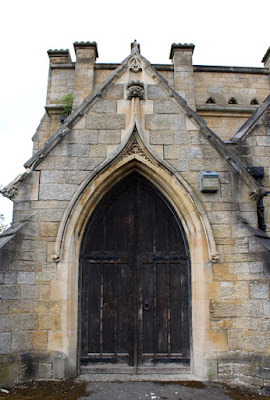 |
| Coarse gritty sandstone at the Crookes Cemetery Chapel |
Having ticked off Lydgate Lane Council School from my list of the Sheffield Board Schools to visit in 2021, I continued my walk along Headland Road until I reached the entrance to Crookes Cemetery. Here, I was very surprised to discover that the gate piers and walls are built in a Jurassic oolitic and shelly limestone. The Cemetery Chapel apparently uses Monks Park stone from Wiltshire, so it is safe to assume that the same stone has been used for the entrance.
This is a limestone that I am familiar with from working in the building restoration industry in London, where it has been used to build Lancaster House, Apsley House and Canada House. It is also one of the stones suitable for restoring Bath Stone, the generic name for limestone from the Bath region that was brought to the capital and widely used for dressings in a variety of historic buildings built in brick, flint and Kentish Ragstone.
The plinth and pier caps are constructed of a very coarse grained cross-bedded sandstone, which has weathered with a greyish patina. It looks to me like one of the various coarse grained sandstones that are obtained from the Millstone Grit Group and the Pennine Lower Coal Measures Formation in the area around the Rivelin Valley and Loxley Valley.
Several blocks of Monks Park stone in the walling have been renewed with sandstone and the sections above the pedestrian entrances have been completely replaced, with long sandstone lintels incongruously being laid on the moulded sections of the dismantled arches and roughly tooled coping stones placed above these.
Looking closely at the limestone, it has not performed very well in Sheffield's industrial environment - the result of sulphurous atmospheric pollution that was once prevalent in the city and exacerbated by the northern climate - and its surface has spalled in many places.
I then continue down to the Cemetery Chapel, which was built in 1908 to a Gothic Revival style design by Messrs C. and C.M.E Hadfield, who were the son and grandson respectively of Matthew Ellison Hadfield, an eminent architect known particularly for his work on Roman Catholic churches and St. Michael’s Cemetery Chapel and the Cholera Monument in Sheffield.
Even at a distance, I was struck by the distinctive very patchy colouration of the sandstone, which varies from grey to orange and I was immediately reminded of an article about the Sheffield Royal Infirmary on the Sheffield Area Geology Trust website, where the Loxley Edge Rock is thought to be the building stone used throughout.
I had only seen this building once and didn’t study it closely, but I have since considered it to be a reference building for this very often coarse grained sandstone, whose main outcrop is in north-west Sheffield - especially since the author Peter Kennet has undertaken considerable research.
The reference to stone coming from a quarry on the Rivelin Valley in “It Comes to Us All: A Portrait of Crookes Cemetery” by Julie Stone, if based on a reliable source, makes it more likely that the stone comes from the Chatsworth Grit – with the nearby Bell Hagg quarry for example producing such stone - although not entirely ruling out the Loxley Edge Rock.
Wherever I have seen outcrops of the Chatsworth Grit along the gritstone edges of the Peak District National Park or along the Rivelin Valley, it has significant amounts of rounded pebbles that are typically no more than half an inch (12mm) in diameter and are scattered amongst predominantly very coarse angular grains or concentrated in thin pebbly bands.
I didn’t notice any obvious pebbles in the walling stone here and the geological memoir for Sheffield states that in the Coal Measures, the Crawshaw Sandstone and in places, the Loxley Edge Rock, produced a coarse, massive building stone like the Chatsworth Grit - a reminder that stone identification and matching for restoration purposes is often not straightforward, with documentary evidence often required to confirm the provenance.
Looking closely at the masonry, an essentially grey variety of the sandstone has been selected for plain sawn dressings, band courses and cappings to buttresses, with Monks Park stone used for the finely carved decorative features around the doorway and on the south gable end.












No comments:
Post a Comment